VRRP能够在不改变组网的情况下,将多台路由器虚拟成一个虚拟路由器,通过配置虚拟路由器的IP地址为默认网关,实现网关的备份
协议版本:VRRPv2(常用)和VRRPv3
VRRPv2仅适用于IPv4网络,VRROv3适用于IPv4和IPv6网络
VRRP协议报文:
只有一种报文:Advertisement报文,其目的IP地址是224.0.0.18,目的MAC地址是01-00-5e-00-00-12,协议号是112
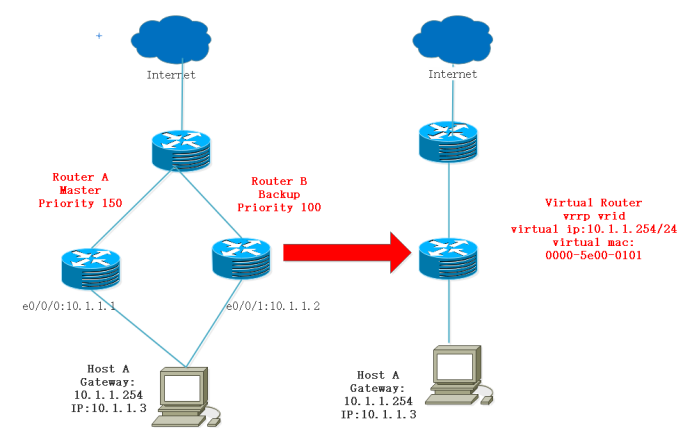
过程:
1、优先级越高,越优先,RouterA的优先级高于B,故A为主路,B为备用路,当主路出现故障时,备用路开启
2、VRRP就是将多个路由器虚拟成一个虚拟路由器,RouterA和B转化成一个虚拟的路由器,该路由器包含虚拟的IP和MAC地址
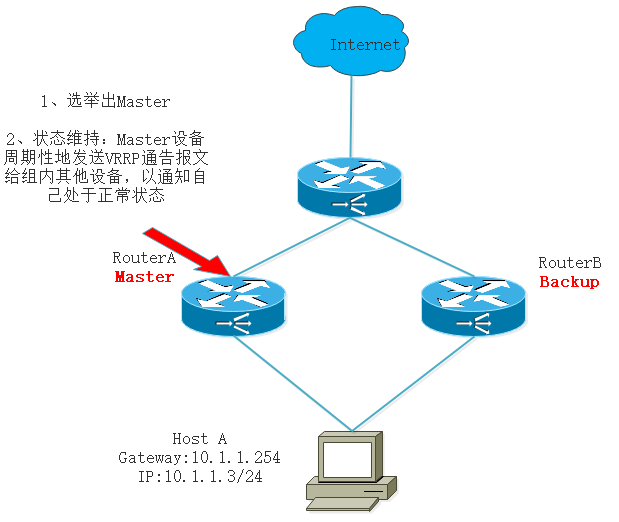
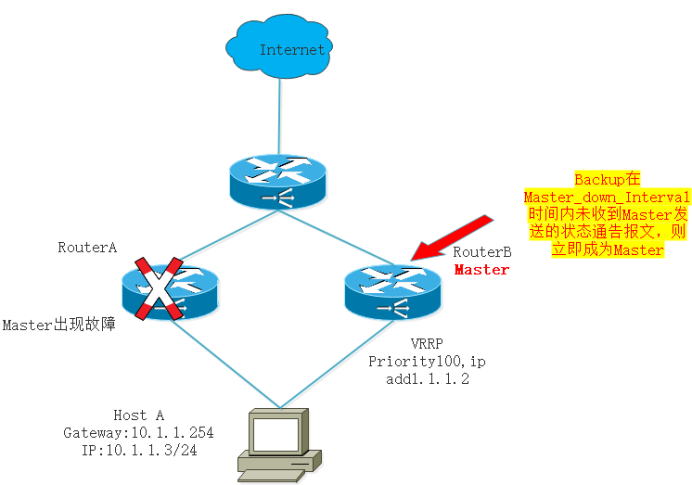


当网关路由器RouterA出现故障时,本网段内以该设备为网关的主机都不能与Internet进行通信,从而引出VRRP
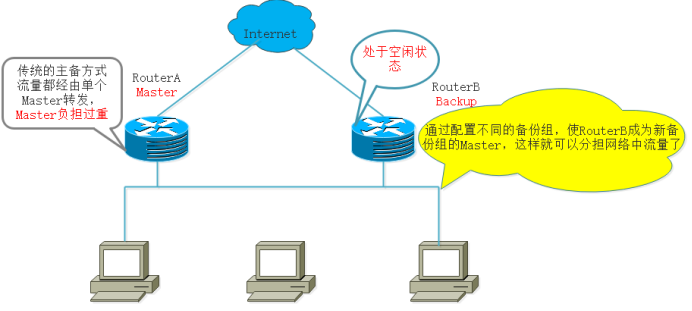
vrrp vrid 1 virtual-ip 192.168.10.1 ###配置虚拟IP地址
vrrp vrid 1 priority 120 ###配置优先级120
vrrp vrid 1 track interface GigabitEthernet0/0/1 ###配置监听端口GigabitEthernet0/0/1,当这个地方down 优先级减10(默认减10)
vrrp vrid 1 track interface GigabitEthernet0/0/2 ###配置监听端口GigabitEthernet0/0/2,当这个地方down 优先级减10
如图所示
要求:
LSW1作为vlan10的主路由器,LSW3作为备用路由器
LSW3作为vlan20的主路由器,LSW1作为备用路由器
观察网络拓扑完整时PC1、PC2的数据发送方向,应从主路上经过
当LSW1断开时观察两者的状态变化,观察R1上路由的变化
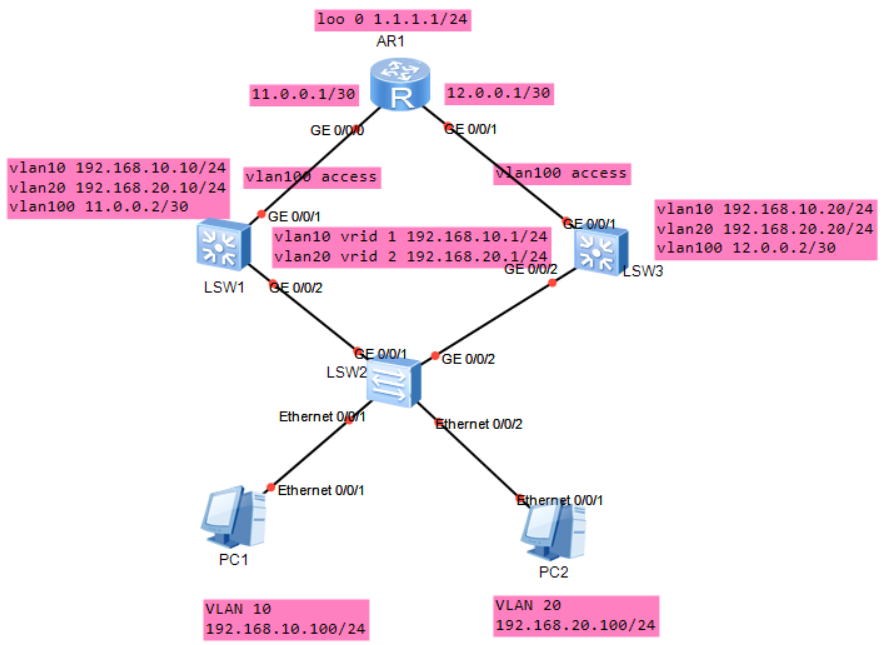
思路分析:
1、进行VLAN划分,并在各个端口进行Access、Trunk口划分
2、用VLANIF添加IP地址,并进行VRRP的配置(虚拟网关、优先级、端口监听)
3、配置LSW1、LSW3以及R1的路由
具体步骤如下:
1、PC1、PC2添加IP地址以及网关(因为跨网段通信需要配置网关),步骤省略;
2、在LSW2进行配置,VLAN划分,命令如下:
1 [Huawei]sys SW2
2 [SW2]v b 10 20
3 [SW2]int e0/0/1
4 [SW2-Ethernet0/0/1]p l a
5 [SW2-Ethernet0/0/1]p d v 10
6 [SW2-Ethernet0/0/1]un sh
7 [SW2-Ethernet0/0/1]int e0/0/2
8 [SW2-Ethernet0/0/2]p l a
9 [SW2-Ethernet0/0/2]p d v 20
10 [SW2-Ethernet0/0/2]un sh
11 [SW2-Ethernet0/0/2]int g0/0/1
12 [SW2-GigabitEthernet0/0/1]p l t
13 [SW2-GigabitEthernet0/0/1]p t a v 10 20
14 [SW2-GigabitEthernet0/0/1]un sh
15 [SW2-GigabitEthernet0/0/1]int g0/0/2
16 [SW2-GigabitEthernet0/0/2]p l t
17 [SW2-GigabitEthernet0/0/2]p t a v 10 20
18 [SW2-GigabitEthernet0/0/2]un sh
3、在LSW1上进行配置,它作为VLAN10的主路由,VLAN20的备用路由,VLANIF进行IP地址添加以及VRRP配置,命令如下:
1 <Huawei>sys
2 [Huawei]sys SW1
3 [SW1]v b 10 20 100
4 [SW1]int g0/0/2
5 [SW1-GigabitEthernet0/0/2]p l t
6 [SW1-GigabitEthernet0/0/2]p t a v 10 20
7 [SW1-GigabitEthernet0/0/2]int g0/0/1
8 [SW1-GigabitEthernet0/0/1]p l a
9 [SW1-GigabitEthernet0/0/1]p d v 100
10 [SW1-GigabitEthernet0/0/1]dis vlan
11 [SW1-GigabitEthernet0/0/1]q
12 [SW1]int vlanif10
13 [SW1-Vlanif10]ip add 192.168.10.10 24
14 [SW1-Vlanif10]vrrp vrid 1 virtual-ip 192.168.10.1
15 [SW1-Vlanif10]vrrp vrid 1 priority 120 //优先级设为120
16 [SW1-Vlanif10]vrrp vrid 1 track interface GigabitEthernet 0/0/1 //监听端口,只在主路监听即可,VLAN20不用监听
17 [SW1-Vlanif10]vrrp vrid 1 track interface GigabitEthernet 0/0/2
18 [SW1-Vlanif10]int vlanif20
19 [SW1-Vlanif20]ip add 192.168.20.10 24
20 [SW1-Vlanif20]vrrp vrid 2 virtual-ip 192.168.20.1
21 [SW1-Vlanif20]vrrp vrid 2 priority 115
22 [SW1-Vlanif20]int vlanif100
23 [SW1-Vlanif100]ip add 11.0.0.2 30
24 [SW1-Vlanif100]q
25 [SW1]ip route-static 0.0.0.0 0.0.0.0 11.0.0.1 //默认路由
4、在LSW3上面配置,方法同LSW1的配置,只不过它作为VLAN20的主路由,VLAN10的备用路由,命令如下:
1 [Huawei]sys SW3
2 [SW3]v b 10 20 100
3 [SW3]int g0/0/2
4 [SW3-GigabitEthernet0/0/2]p l t
5 [SW3-GigabitEthernet0/0/2]p t a v 10 20
6 [SW3-GigabitEthernet0/0/2]int g0/0/1
7 [SW3-GigabitEthernet0/0/1]p l a
8 [SW3-GigabitEthernet0/0/1]p d v 100
9 [SW3-GigabitEthernet0/0/1]int vlanif20
10 [SW3-Vlanif20]ip add 192.168.20.20 24
11 [SW3-Vlanif20]vrrp vrid 2 virtual-ip 192.168.20.1
12 [SW3-Vlanif20]vrrp vrid 2 priority 120
13 [SW3-Vlanif20]vrrp vrid 2 track interface GigabitEthernet 0/0/1
14 [SW3-Vlanif20]vrrp vrid 2 track interface GigabitEthernet 0/0/2
15 [SW3-Vlanif20]int vlanif10
16 [SW3-Vlanif10]ip add 192.168.10.20 24
17 [SW3-Vlanif10]vrrp vrid 1 virtual-ip 192.168.10.1
18 [SW3-Vlanif10]vrrp vrid 1 priority 115
19 [SW3-Vlanif10]int vlanif100
20 [SW3-Vlanif100]ip add 12.0.0.2 30
21 [SW3-Vlanif100]q
22 [SW3]ip route-static 0.0.0.0 0.0.0.0 12.0.0.1
5、在R1上面添加IP地址,并配置路由,静态路由和浮动路由,命令如下:
1 [Huawei]sysname R1
2 [R1]int g0/0/1
3 [R1-GigabitEthernet0/0/1]ip add 12.0.0.1 30
4 [R1-GigabitEthernet0/0/1]int g0/0/0
5 [R1-GigabitEthernet0/0/0]ip add 11.0.0.1 30
6 [R1-GigabitEthernet0/0/0]q
7 [R1]int LoopBack 0
8 [R1-LoopBack0]ip add 1.1.1.1 24
9 [R1-LoopBack0]q
10 [R1]ip route-static 192.168.10.0 24 11.0.0.2
11 [R1]ip route-static 192.168.10.0 24 12.0.0.2 preference 70 //浮动路由
12 [R1]ip route-static 192.168.20.0 24 12.0.0.2
13 [R1]ip route-static 192.168.20.0 24 11.0.0.2 preference 70
6、测试
在PC1上ping回环地址1.1.1.1,如图所示,连接成功
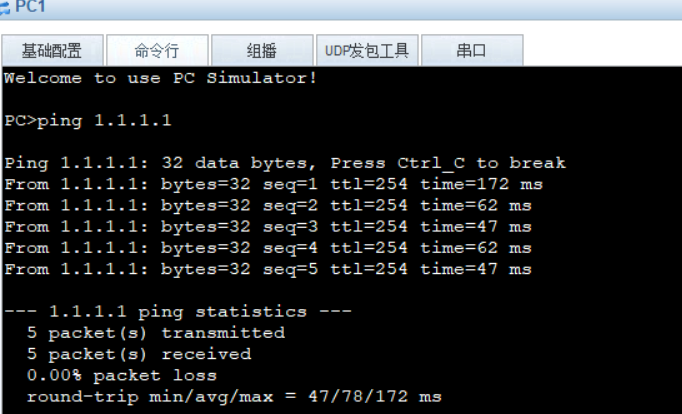
R1的g0/0/0接口,shutdown之后,观察备用路由是否开启
查看SW3的VRRP表,显示开启
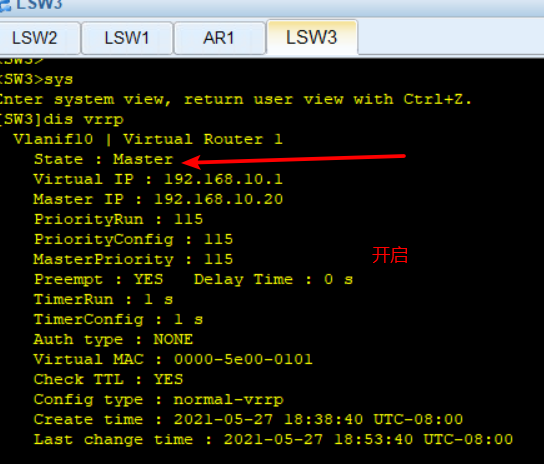
在SW3上抓包数据

1、配置VRRP时要分清主路和备用路由分别划分的VLAN
2、主路由上面需要在两个端口设置监听,备用路由则不需要
3、优先级设置,主路由的优先级要高于备用路由的优先级,优先级越高越优先
4、浮动路由的配置,优先级默认为60,备用路由的优先级要高于主路的默认值60(此优先级跟VRRP的优先级不一样)
原文:https://www.cnblogs.com/weq0805/p/14817519.html